|
|
#861 |
|
⊙▃⊙
|
Daily Suspicious0bserver's Weather Post:
March 8, 2014 What's in the sky tonight? March 8, 2014 -As the stars begin to come out, the first-quarter Moon shines above Orion standing in the south. -Daylight-saving time begins at 2 a.m. Sunday morning for most of North America. Clocks spring forward an hour. -NOAA forecasters estimate a 25% to 35% chance of minor geomagnetic storms on March 8-9 when a solar wind stream is expected to brush against Earth's magnetic field. High-latitude sky watchers should be alert for auroras. The best time to look is during the hours around local midnight. -Next month, Earth and Mars will converge for their closest approach of 2014. Opposition occurs on April 8th. That's when Mars rises in the east at sunset, almost perfectly opposite the sun, and soars overhead at midnight shining 8 times brighter than a 1st-magnitude star. Although closest approach is still weeks away away, astronomers are already enjoying great views of the Red Planet. Australian astrophotographer Anthony Wesley took this picture using a 16-inch telescope on March 6th. -His high-resolution image shows orographic clouds over the Elysium volcanoes just north of the Martian equator and an even brighter blue cloud over the Hellas impact basin in the southern hemisphere. Hellas is the lowest point on Mars, and some of the haze evident there could be icy fog. Getting such Hubblesque results from a 16-inch telescope requires a combination of good seeing and long years of experience. Wesley, who is one of the world's top amateur astrophotographers, had both working for him on the morning of March 6th. "Skies were stable and clear," he says. "Using a Point Grey Research low-light Grasshopper3 camera, I recorded 2 minutes through red, green and blue filters with red @ 83fps, green @ 70fps and blue @ 50fps. I sorted all the frames according to image sharpness and stacked the best 2000 in each channel to make the color image, with additional wavelet sharpening in Registax, deconvolution in Astra Image and final color correction and touchups+captioning in the GIMP." Observers with less experience can take good photos, too, especially as March gives way to April and Mars approaches Earth. Look for burnt-orange Mars rising in the east around around 10 p.m. about 5° from the blue 1st-magnitude star Spica. The Moon passes by Mars on March 19-20 and provides a convenient "landmark" for finding the Red Planet. -From Earth's point of view, Mars is approaching opposition. The Red Planet is in the midnight sky, almost directly opposite the sun. NASA's STEREO-Behind spacecraft has a different point of view. STEREO-B is stationed over the farside of the sun. From there, Mars and the Sun are in conjunction. This coronagraph image taken by STEREO-B on March 5th shows the sun and Mars side-by-side. On the day this picture was taken, several explosions occured on the farside of the sun, hurling CMEs into space.  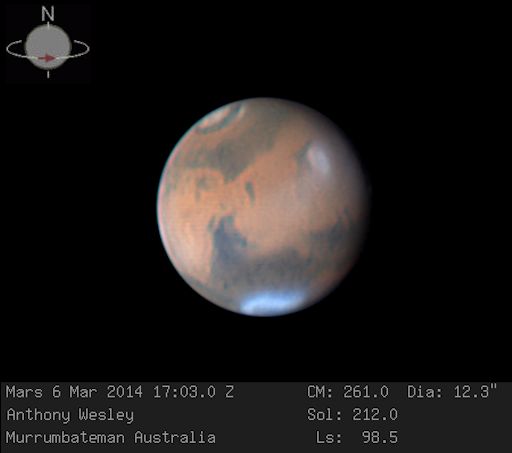 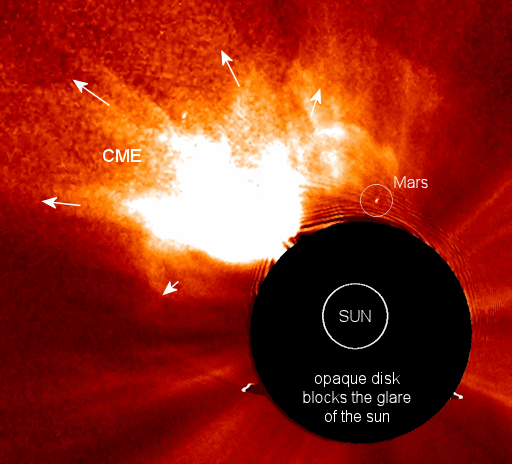 Astro Picture of the Day: March 8, 2014  Get out your red/blue glasses (red for the left eye) and look out over this expansive martian landscape. The panoramic stereo view is composed of images from the roving Curiosity's Navcam taken at a rest stop during a 100 meter drive on Sol 548 (February 19). The 5.5 kilometer high peak of Mount Sharp, also known as Aeolis Mons, is on the horizon, its base a destination for Curiosity. In the foreground are rows of striated rocks along the Junda outcrop. Centered toward the south-southeast the scene spans 160 degrees.
__________________
1st in Kommisar's 2009 SM Tournament 1st in I Love You`s 2009 New Year`s Tournament 3rd in EnR's Mashfest '08 tournament 5th in Phynx's Unofficial FFR Tournament 9th in D3 of the 2008-2009 4th Official FFR Tournament 10th in D5 of the 2010 5th Official FFR Tournament 10th in D6 of the 2011-2012 6th Official FFR Tournament FMO AAA Count: 71 FGO AAA Count: 10 Bluearrowll = The Canadian player who can not detect awkward patterns. If it's awkward for most people, it's normal for Terry. If the file is difficult but super straight forward, he has issues. If he's AAAing a FGO but then heard that his favorite Hockey team was losing by a point, Hockey > FFR PS: Cool AAA's Terry - I Love You An Alarm Clock's Haiku beep beep beep beep beep beep beep beep beep beep beep beep beep beep beep beep beep - ieatyourlvllol |
|
|

|
|
|
#862 |
|
⊙▃⊙
|
Daily Suspicious0bserver's Weather Post:
March 9, 2014 What's in the sky tonight? March 9, 2014 -Jupiter shines above the Moon this evening, as shown above. Although they look fairly close together, Jupiter is almost 1,800 times farther away — and 40 times larger in diameter. -Episode 1 of the reborn Cosmos series airs tonight (Fox network, 9 p.m. Eastern, 8 Central). -NOAA forecasters estimate a 30% chance of minor geomagnetic storms on March 9th when a solar wind stream is expected to brush against Earth's magnetic field. High-latitude sky watchers should be alert for auroras. The best time to look is during the hours around local midnight.  Astro Picture of the Day: March 9, 2014 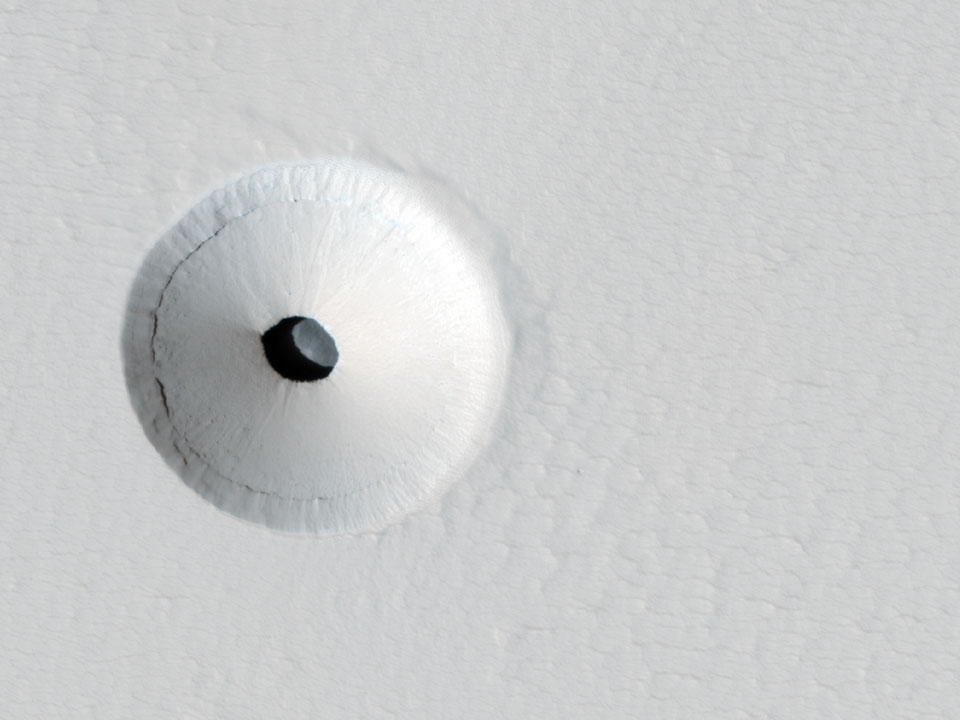 What created this unusual hole in Mars? The hole was discovered by chance in 2011 on images of the dusty slopes of Mars' Pavonis Mons volcano taken by the HiRISE instrument aboard the robotic Mars Reconnaissance Orbiter currently circling Mars. The hole appears to be an opening to an underground cavern, partly illuminated on the image right. Analysis of this and follow-up images revealed the opening to be about 35 meters across, while the interior shadow angle indicates that the underlying cavern is roughly 20 meters deep. Why there is a circular crater surrounding this hole remains a topic of speculation, as is the full extent of the underlying cavern. Holes such as this are of particular interest because their interior caves are relatively protected from the harsh surface of Mars, making them relatively good candidates to contain Martian life. These pits are therefore prime targets for possible future spacecraft, robots, and even human interplanetary explorers.
__________________
1st in Kommisar's 2009 SM Tournament 1st in I Love You`s 2009 New Year`s Tournament 3rd in EnR's Mashfest '08 tournament 5th in Phynx's Unofficial FFR Tournament 9th in D3 of the 2008-2009 4th Official FFR Tournament 10th in D5 of the 2010 5th Official FFR Tournament 10th in D6 of the 2011-2012 6th Official FFR Tournament FMO AAA Count: 71 FGO AAA Count: 10 Bluearrowll = The Canadian player who can not detect awkward patterns. If it's awkward for most people, it's normal for Terry. If the file is difficult but super straight forward, he has issues. If he's AAAing a FGO but then heard that his favorite Hockey team was losing by a point, Hockey > FFR PS: Cool AAA's Terry - I Love You An Alarm Clock's Haiku beep beep beep beep beep beep beep beep beep beep beep beep beep beep beep beep beep - ieatyourlvllol |
|
|

|
|
|
#863 |
|
⊙▃⊙
|
Well as of today this thread is 2 years old. In a way, very little has changed from when it first opened. There's new features, new viewers, but other than that, it's still the same at its core. I've somehow managed to get up every morning for the past 2 years, scour some information hubs about what is happening in space at any given day, and report the findings here without missing a beat, even if it meant I had to pass the torch onto someone else while I went on a camping / photography trip for a few days (looking at you Sky Kitten, thanks for all your help!) I would also like to thank all who have decided to take a glance at the thread whether regularly or just to see what the fuss is about. The thread has never been as popular as it is today. Having said that, I keep track of how people visit the thread throughout the years. Here is what I have found:
Visitors Per Day, Year 2: Visitors Per Day, Since Inception: Viewership Growth, Year 2: Viewership Growth, Since Inception: Daily Suspicious0bserver's Weather Post: March 10, 2014 What's in the sky tonight? March 10, 2014 -The Moon forms a distorted rectangle with Jupiter, Castor, and Pollux this evening. In addition, the Moon and Jupiter form a bent line of three with Procyon to their lower left. -Mercury (magnitude +0.2) is low above the east-southeast horizon during dawn, about 20° lower left of bright Venus. -Saturn (magnitude +0.4, in Libra) rises around 11 p.m. and is highest in the south before dawn. By then it's far left of Mars and Spica, and less far to the upper right of Mars-colored Antares.  Astro Picture of the Day: March 10, 2014 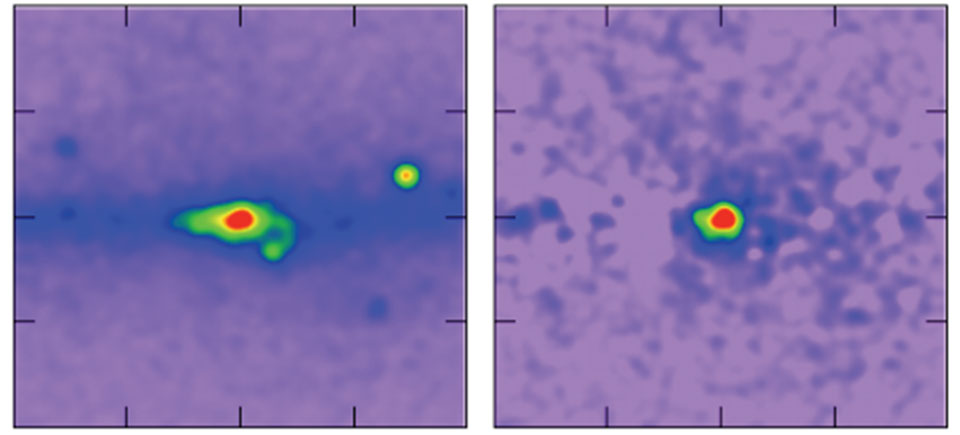 What is creating the gamma rays at the center of our Galaxy? Excitement is building that one answer is elusive dark matter. Over the past few years the orbiting Fermi Gamma-ray Space Telescope has been imaging our Galaxy's center in gamma-rays. Repeated detailed analyses indicate that the region surrounding the Galactic center seems too bright to be accounted by known gamma-ray sources. A raw image of the Galactic Center region in gamma-rays is shown above on the left, while the image on the right has all known sources subtracted -- leaving an unexpected excess. An exciting hypothetical model that seems to fit the excess involves a type of dark matter known as WIMPs, which may be colliding with themselves to create the detected gamma-rays. This hypothesis is controversial, however, and debate and more detailed investigations are ongoing. Finding the nature of dark matter is one of the great quests of modern science, as previously this unusual type of cosmologically pervasive matter has shown itself only through gravitation. The hypothesis can be found here: https://www.simonsfoundation.org/qua...l-strengthens/
__________________
1st in Kommisar's 2009 SM Tournament 1st in I Love You`s 2009 New Year`s Tournament 3rd in EnR's Mashfest '08 tournament 5th in Phynx's Unofficial FFR Tournament 9th in D3 of the 2008-2009 4th Official FFR Tournament 10th in D5 of the 2010 5th Official FFR Tournament 10th in D6 of the 2011-2012 6th Official FFR Tournament FMO AAA Count: 71 FGO AAA Count: 10 Bluearrowll = The Canadian player who can not detect awkward patterns. If it's awkward for most people, it's normal for Terry. If the file is difficult but super straight forward, he has issues. If he's AAAing a FGO but then heard that his favorite Hockey team was losing by a point, Hockey > FFR PS: Cool AAA's Terry - I Love You An Alarm Clock's Haiku beep beep beep beep beep beep beep beep beep beep beep beep beep beep beep beep beep - ieatyourlvllol |
|
|

|
|
|
#864 |
|
Signature Extraordinare~~
Song Submission & Events Manager
|
Just wanted to come in here and thank you for your dedication on this. Not many people may sit down and read the stuff you're dishing out, but I've been keeping track on it enough to know that today marks your 2nd year since your first post on this thread.
<3 ya Terry. |
|
|

|
|
|
#865 |
|
⊙▃⊙
|
Daily Suspicious0bserver's Weather Post:
March 11, 2014 What's in the sky tonight? March 11, 2014 -Late twilight is when Sirius now stands due south, and twilight is also a time when the atmospheric seeing sometimes steadies. So it may be a good time to try to detect the faint white-dwarf companion of Sirius, now 10.2″ east of dazzling Sirius A. -Sunspot AR2002 poses a growing threat for solar flares. Since the week began, the active region has more than tripled in size. It now has more than a dozen dark cores and sprawls across 100,000 km of solar terrain. Karzaman Ahmad sends this picture, taken just hours ago, from the Langkawi National Observatory in Malaysia. "AR2002 is so large," says Ahmad, "that I was able to photograph it using an ordinary 11-inch Celestron telescope capped with a Thousand Oaks Glass Filter." The exceptionally crisp image shows thousands of boiling granules surrounding the sunspot's dark cores. Each granule is about the size of Texas. -A 48-hour movie from NASA's Solar Dynamics Observatory shows the sunspot's development. The rapid growth of AR2002 has destabilized its magnetic field, which makes it more likely to erupt. NOAA forecasters estimate a 60% chance of M-class flares and a 10% chance of X-class flares during the next 24 hours. 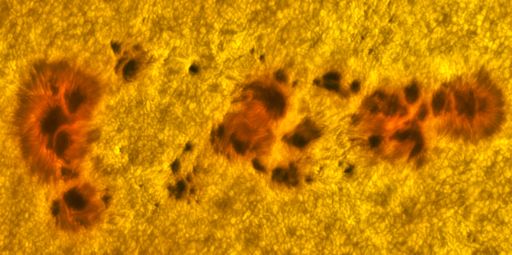 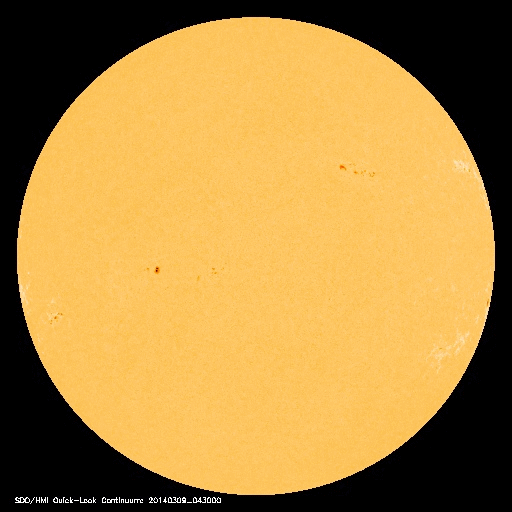 Astro Picture of the Day: March 11, 2014  In the heart of the Rosette Nebula lies a bright open cluster of stars that lights up the nebula. The stars of NGC 2244 formed from the surrounding gas only a few million years ago. The above image taken in January using multiple exposures and very specific colors of Sulfur (shaded red), Hydrogen (green), and Oxygen (blue), captures the central region in tremendous detail. A hot wind of particles streams away from the cluster stars and contributes to an already complex menagerie of gas and dust filaments while slowly evacuating the cluster center. The Rosette Nebula's center measures about 50 light-years across, lies about 4,500 light-years away, and is visible with binoculars towards the constellation of the Unicorn (Monoceros).
__________________
1st in Kommisar's 2009 SM Tournament 1st in I Love You`s 2009 New Year`s Tournament 3rd in EnR's Mashfest '08 tournament 5th in Phynx's Unofficial FFR Tournament 9th in D3 of the 2008-2009 4th Official FFR Tournament 10th in D5 of the 2010 5th Official FFR Tournament 10th in D6 of the 2011-2012 6th Official FFR Tournament FMO AAA Count: 71 FGO AAA Count: 10 Bluearrowll = The Canadian player who can not detect awkward patterns. If it's awkward for most people, it's normal for Terry. If the file is difficult but super straight forward, he has issues. If he's AAAing a FGO but then heard that his favorite Hockey team was losing by a point, Hockey > FFR PS: Cool AAA's Terry - I Love You An Alarm Clock's Haiku beep beep beep beep beep beep beep beep beep beep beep beep beep beep beep beep beep - ieatyourlvllol |
|
|

|
|
|
#866 |
|
⊙▃⊙
|
Daily Suspicious0bserver's Weather Post:
March 12, 2014 What's in the sky tonight? March 12, 2014 -It's still 8 days until spring, so Orion's Belt isn't yet quite horizontal in early evening. But it's getting there, as Orion tips down toward the southwest for its seasonal decline and eventual departure. -Unlike Jupiter's moons Io and Europa, Ganymede and Callisto are darker than most of Jupiter's surface, as seen dramatically in this high-resolution image of Ganymede near Jupiter's central meridian taken by Christopher Go at 11:20 UT March 2nd. You might even mistake it for its shadow! (The faint light ring that appears inside Ganymede is a processing artifact caused by its sharp dark edge against the lighter background). South is up. The reddish oval near Ganymede is Oval BA in the South Temperate Zone.  Astro Picture of the Day: March 12, 2014 Does the Sun change as it rotates? Yes, and the changes can vary from subtle to dramatic. In the above time-lapse sequences, our Sun -- as imaged by NASA's Solar Dynamics Observatory -- is shown rotating though the entire month of January. In the large image on the left, the solar chromosphere is depicted in ultraviolet light, while the smaller and lighter image to its upper right simultaneously shows the more familiar solar photosphere in visible light. The rest of the inset six Sun images highlight X-ray emission by relatively rare iron atoms located at different heights of the corona, all false-colored to accentuate differences. The Sun takes just under a month to rotate completely -- rotating fastest at the equator. A large and active sunspot region rotates into view soon after the video starts. Subtle effects include changes in surface texture and the shapes of active regions. Dramatic effects include numerous flashes in active regions, and fluttering and erupting prominences visible all around the Sun's edge. This year our Sun is near its Solar maximum activity of its 11-year magnetic cycle. As the video ends, the same large and active sunspot region previously mentioned rotates back into view, this time looking differently.
__________________
1st in Kommisar's 2009 SM Tournament 1st in I Love You`s 2009 New Year`s Tournament 3rd in EnR's Mashfest '08 tournament 5th in Phynx's Unofficial FFR Tournament 9th in D3 of the 2008-2009 4th Official FFR Tournament 10th in D5 of the 2010 5th Official FFR Tournament 10th in D6 of the 2011-2012 6th Official FFR Tournament FMO AAA Count: 71 FGO AAA Count: 10 Bluearrowll = The Canadian player who can not detect awkward patterns. If it's awkward for most people, it's normal for Terry. If the file is difficult but super straight forward, he has issues. If he's AAAing a FGO but then heard that his favorite Hockey team was losing by a point, Hockey > FFR PS: Cool AAA's Terry - I Love You An Alarm Clock's Haiku beep beep beep beep beep beep beep beep beep beep beep beep beep beep beep beep beep - ieatyourlvllol |
|
|

|
|
|
#867 |
|
⊙▃⊙
|
Daily Suspicious0bserver's Weather Post:
March 13, 2014 What's in the sky tonight? March 13, 2014 -Look left of the Moon this evening for Regulus. It's the bottom star in the handle of the Sickle of Leo. -Departing sunspot AR1996 erupted on March 12th at 2234 UT, producing an M9-category blast that almost crossed into X-territory. NASA's Solar Dynamics Observatory captured the extreme ultra-violet flash. UV radiation from the flare caused waves of ionization to ripple through Earth's upper atmosphere, but they quickly subsided. Otherwise the flare was not geoeffective. The sunspot's location near the sun's eastern limb mitigated any Earth effects. The next flare could have a greater influence on our planet. Sunspot AR2002 is directly facing Earth, and it has a 'beta-gamma-delta' magnetic field that harbors energy for strong explosions. NOAA forecasters estimate an 80% chance of M-class flares and a 15% chance of X-flares on March 13th. -Observers around the Arctic Circle were surprised last night when the skies overhead erupted in swirls of verdant color. Rayann Elzein sends this picture from Inari in the Finnish Lapland. "Although there was no forecast of strong activity, auroras were dancing high in the sky--very bright and very fast," says Elzein. "They were the most breathtaking auroras that I have ever seen up here in Lapland!" The unexpected storm, a relatively minor G1-class event, was caused by a fluctuation in the interplanetary magnetic field (IMF). As March 12th turned to 13th, the IMF tilted south, opening a crack in Earth's magnetosphere. Solar wind poured in and fueled the display.  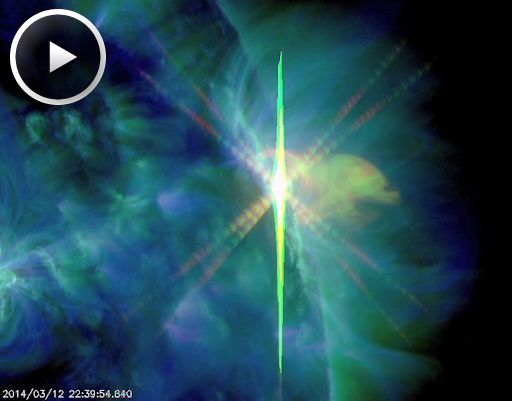 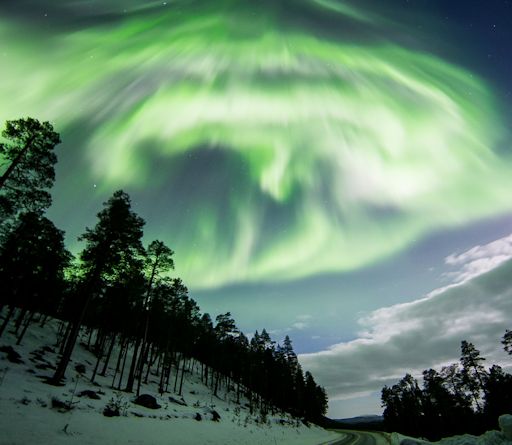 News Posted Today: March 4, 2014 Zodiacal Light in the Evening  Astro Picture of the Day: March 13, 2014 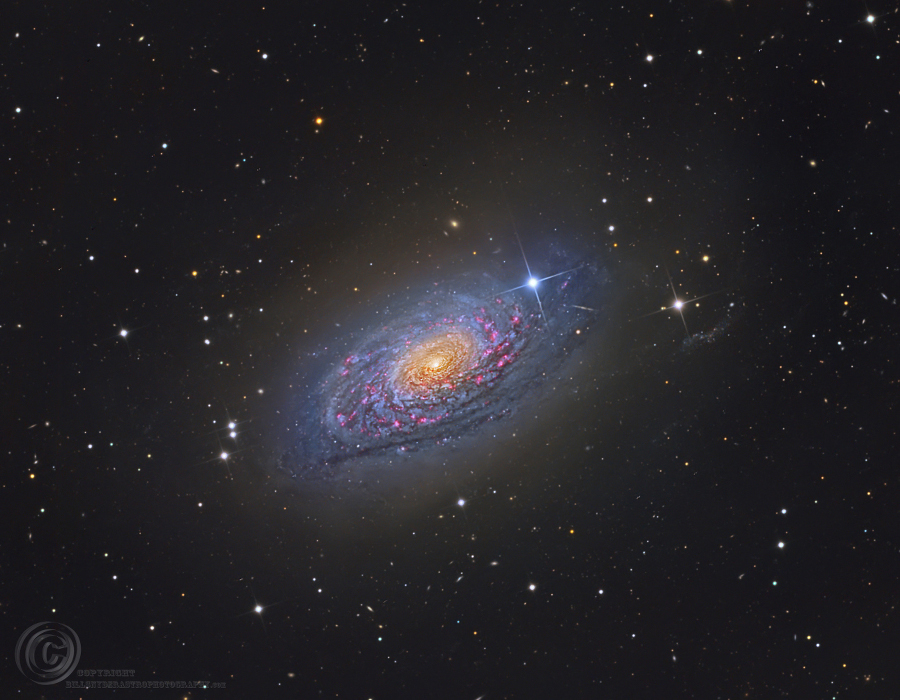 A bright spiral galaxy of the northern sky, Messier 63 is about 25 million light-years distant in the loyal constellation Canes Venatici. Also cataloged as NGC 5055, the majestic island universe is nearly 100,000 light-years across. That's about the size of our own Milky Way Galaxy. Known by the popular moniker, The Sunflower Galaxy, M63 sports a bright yellowish core in this sharp, colorful galaxy portrait. Its sweeping blue spiral arms are streaked with cosmic dust lanes and dotted with pink star forming regions. A dominant member of a known galaxy group, M63 has faint, extended features that could be the result of gravitational interactions with nearby galaxies. In fact, M63 shines across the electromagnetic spectrum and is thought to have undergone bursts of intense star formation.
__________________
1st in Kommisar's 2009 SM Tournament 1st in I Love You`s 2009 New Year`s Tournament 3rd in EnR's Mashfest '08 tournament 5th in Phynx's Unofficial FFR Tournament 9th in D3 of the 2008-2009 4th Official FFR Tournament 10th in D5 of the 2010 5th Official FFR Tournament 10th in D6 of the 2011-2012 6th Official FFR Tournament FMO AAA Count: 71 FGO AAA Count: 10 Bluearrowll = The Canadian player who can not detect awkward patterns. If it's awkward for most people, it's normal for Terry. If the file is difficult but super straight forward, he has issues. If he's AAAing a FGO but then heard that his favorite Hockey team was losing by a point, Hockey > FFR PS: Cool AAA's Terry - I Love You An Alarm Clock's Haiku beep beep beep beep beep beep beep beep beep beep beep beep beep beep beep beep beep - ieatyourlvllol |
|
|

|
|
|
#868 |
|
⊙▃⊙
|
Daily Suspicious0bserver's Weather Post:
March 14, 2014 What's in the sky tonight? March 14, 2014 -This evening, look for Regulus and the Sickle of Leo above the almost-full Moon. -Today, March 14th (3.14), is Pi day, and all around the world pi-philes are celebrating one of the most compelling and mysterious constants of Nature. Pi appears in equations describing the orbits of planets, the colors of auroras, the structure of DNA. The value of pi is woven into the fabric of life, the universe and ... everything. Humans have struggled to calculate for thousands of years. Divide the circumference of a circle by its diameter; the ratio is pi. Sounds simple, but the devil is in the digits. While the value of is finite, the decimal number is infinitely long. Supercomputers have succeeded in calculating more than 2700 billion digits and they're still crunching. The weirdest way to compute: throw needles at a table or frozen hot dogs on the floor. Party time! http://www.angelfire.com/wa/hurben/buff.html http://www.wikihow.com/Calculate-Pi-...rozen-Hot-Dogs  News Posted Today: March 13, 2014 Regulus Occultation: Asteroid to Black Out Bright Star  Astro Picture of the Day: March 14, 2014  NGC 2685 is a confirmed polar ring galaxy - a rare type of galaxy with stars, gas and dust orbiting in rings perpendicular to the plane of a flat galactic disk. The bizarre configuration could be caused by the chance capture of material from another galaxy by a disk galaxy, with the captured debris strung out in a rotating ring. Still, observed properties of NGC 2685 suggest that the rotating ring structure is remarkably old and stable. In this sharp view of the peculiar system also known as Arp 336 or the Helix galaxy, the strange, perpendicular rings are easy to trace as they pass in front of the galactic disk, along with other disturbed outer structures. NGC 2685 is about 50,000 light-years across and 40 million light-years away in the constellation Ursa Major.
__________________
1st in Kommisar's 2009 SM Tournament 1st in I Love You`s 2009 New Year`s Tournament 3rd in EnR's Mashfest '08 tournament 5th in Phynx's Unofficial FFR Tournament 9th in D3 of the 2008-2009 4th Official FFR Tournament 10th in D5 of the 2010 5th Official FFR Tournament 10th in D6 of the 2011-2012 6th Official FFR Tournament FMO AAA Count: 71 FGO AAA Count: 10 Bluearrowll = The Canadian player who can not detect awkward patterns. If it's awkward for most people, it's normal for Terry. If the file is difficult but super straight forward, he has issues. If he's AAAing a FGO but then heard that his favorite Hockey team was losing by a point, Hockey > FFR PS: Cool AAA's Terry - I Love You An Alarm Clock's Haiku beep beep beep beep beep beep beep beep beep beep beep beep beep beep beep beep beep - ieatyourlvllol |
|
|

|
|
|
#869 |
|
⊙▃⊙
|
Daily Suspicious0bserver's Weather Post:
March 15, 2014 What's in the sky tonight? March 15, 2014 -The Big Dipper glitters high in the northeast these evenings, standing on its handle. You probably know that the two stars forming the front of the Dipper's bowl (currently on top) are the Pointers; they point to Polaris, currently to their left. And, you may know that if you follow the curve of the Dipper's handle out and around by a little more than a Dipper length, you'll arc to Arcturus, now rising in the east. But did you know that if you follow the Pointers backward, you'll land in Leo? Draw a line diagonally across the Dipper's bowl from where the handle is attached, continue far on, and you'll go to Gemini. And look at the two stars forming the open top of the Dipper's bowl. Follow this line past the bowl's lip far across the sky, and you crash into Capella. -Amateur astronomers are noting an outbreak of dark magnetic filaments on the sun. The longest, which measure 100,000 km to 250,000 km from end to end, are snaking around the sun's southeastern limb. Sergio Castillo sends this picture from his backyard observatory in Inglewood, CA. "If they collapse, these monster solar filaments could produce a Hyder flare," says Castillo. Indeed, he continues, "one of them erupted just yesterday." With all of the sunspots on the Earthside of the sun currently quieting, these filaments could be the source of greatest solar activity this weekend. Amateur astronomers with solar telescopes are encouraged to monitor developments.  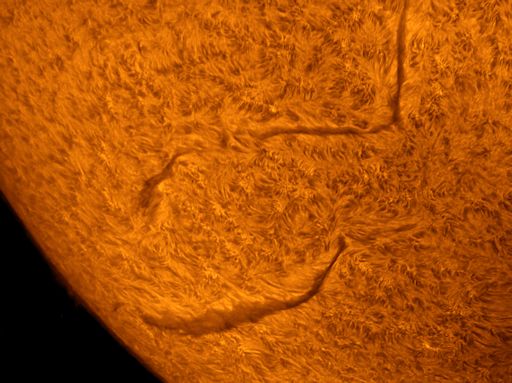 Astro Picture of the Day: March 15, 2014  Get out your red/blue glasses and check out this stereo scene from Taurus-Littrow valley on the Moon! The color anaglyph features a detailed 3D view of Apollo 17's Lunar Rover in the foreground -- behind it lies the Lunar Module and distant lunar hills. Because the world was going to be able to watch the Lunar Module's ascent stage liftoff via the rover's TV camera, this parking place was also known as the VIP Site. In December of 1972, Apollo 17 astronauts Eugene Cernan and Harrison Schmitt spent about 75 hours on the Moon, while colleague Ronald Evans orbited overhead. The crew returned with 110 kilograms of rock and soil samples, more than from any of the other lunar landing sites. Cernan and Schmitt are still the last to walk (or drive) on the Moon.
__________________
1st in Kommisar's 2009 SM Tournament 1st in I Love You`s 2009 New Year`s Tournament 3rd in EnR's Mashfest '08 tournament 5th in Phynx's Unofficial FFR Tournament 9th in D3 of the 2008-2009 4th Official FFR Tournament 10th in D5 of the 2010 5th Official FFR Tournament 10th in D6 of the 2011-2012 6th Official FFR Tournament FMO AAA Count: 71 FGO AAA Count: 10 Bluearrowll = The Canadian player who can not detect awkward patterns. If it's awkward for most people, it's normal for Terry. If the file is difficult but super straight forward, he has issues. If he's AAAing a FGO but then heard that his favorite Hockey team was losing by a point, Hockey > FFR PS: Cool AAA's Terry - I Love You An Alarm Clock's Haiku beep beep beep beep beep beep beep beep beep beep beep beep beep beep beep beep beep - ieatyourlvllol |
|
|

|
|
|
#870 |
|
⊙▃⊙
|
Daily Suspicious0bserver's Weather Post:
March 16, 2014 What's in the sky tonight? March 16, 2014 -Full Moon (exact at 1:08 p.m. EDT). The Moon rises around sunset and shines far below Leo in the evening, as shown above. Later in the night, look far to the Moon's lower left for Mars and fainter Spica. -On March 12th, an unexpected geomagnetic storm erupted around the Arctic Circle. The G1-class event was mostly minor, but a few longitudes experienced something more. Over the Finnish Lapland, geomagnetic activity and the auroras it sparked were locally intense. Juan Carlos Casado photographed the display from Saariselkä, a mountain village in northern Finland. "I took these pictures from the longest toboggan run in the world, in Saariselkä,using a circular fisheye lens,' says Casado. "I was with a group of observers and the reactions of people were very emotional, with shouts, laughter and tears in the eyes!" "Time marks inserted in the full-sized image give an idea of the speed of the phenomenon," he continues. "You can see the big bang of activity (top right) and how only in two minutes the whole sky is filled with auroras." The unexpected storm was caused by a fluctuation in the interplanetary magnetic field (IMF). As March 12th turned to 13th, the IMF tilted south, opening a crack in Earth's magnetosphere. Solar wind poured in and fueled the display. The time difference between the first image in the top left and the last image in the bottom right is 8 minutes. The full size image can be found here: http://spaceweathergallery.com/indiv...pload_id=95488  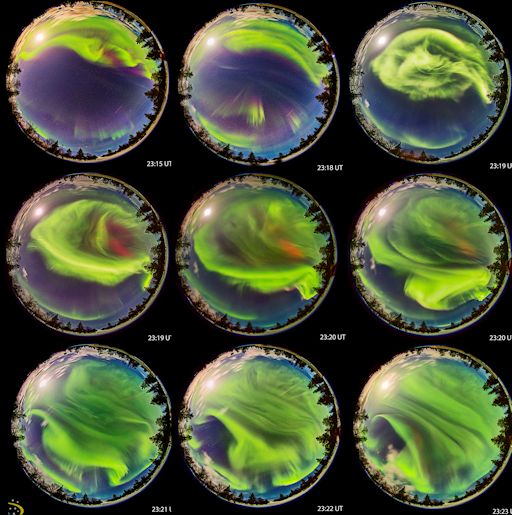 Astro Picture of the Day: March 16, 2014 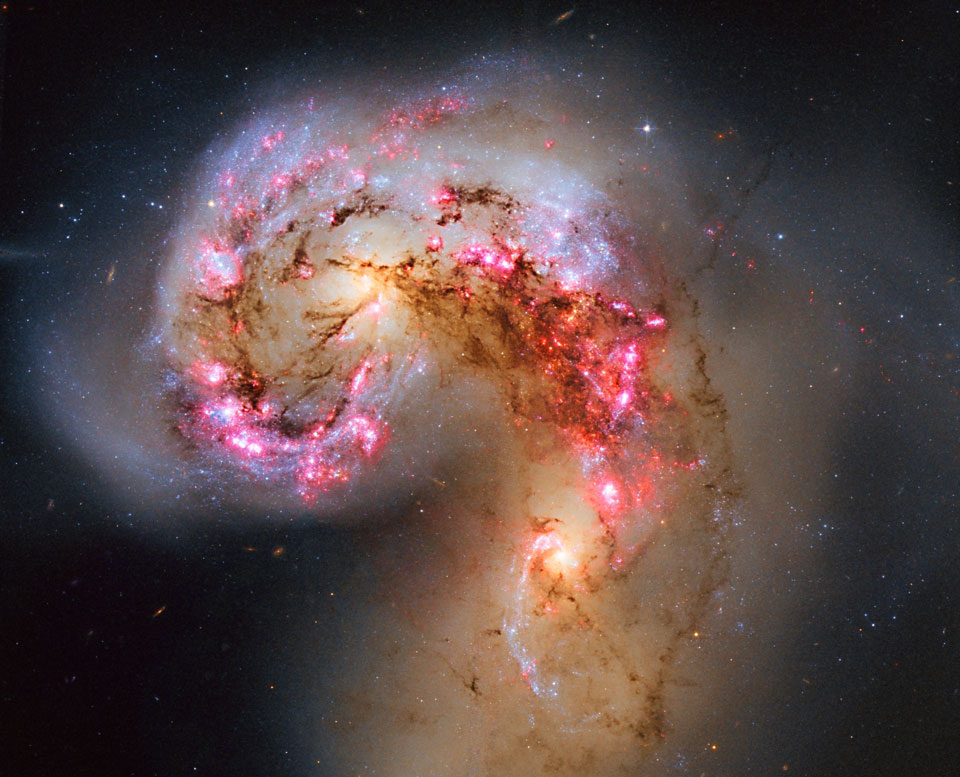 Two galaxies are squaring off in Corvus and here are the latest pictures. When two galaxies collide, the stars that compose them usually do not. That's because galaxies are mostly empty space and, however bright, stars only take up only a small amount of that space. During the slow, hundred million year collision, one galaxy can still rip the other apart gravitationally, and dust and gas common to both galaxies does collide. In this clash of the titans, dark dust pillars mark massive molecular clouds are being compressed during the galactic encounter, causing the rapid birth of millions of stars, some of which are gravitationally bound together in massive star clusters.
__________________
1st in Kommisar's 2009 SM Tournament 1st in I Love You`s 2009 New Year`s Tournament 3rd in EnR's Mashfest '08 tournament 5th in Phynx's Unofficial FFR Tournament 9th in D3 of the 2008-2009 4th Official FFR Tournament 10th in D5 of the 2010 5th Official FFR Tournament 10th in D6 of the 2011-2012 6th Official FFR Tournament FMO AAA Count: 71 FGO AAA Count: 10 Bluearrowll = The Canadian player who can not detect awkward patterns. If it's awkward for most people, it's normal for Terry. If the file is difficult but super straight forward, he has issues. If he's AAAing a FGO but then heard that his favorite Hockey team was losing by a point, Hockey > FFR PS: Cool AAA's Terry - I Love You An Alarm Clock's Haiku beep beep beep beep beep beep beep beep beep beep beep beep beep beep beep beep beep - ieatyourlvllol |
|
|

|
|
|
#871 |
|
⊙▃⊙
|
Daily Suspicious0bserver's Weather Post:
March 17, 2014 What's in the sky tonight? March 17, 2014 -Once the Moon is well up in the southeast late this evening, look below it to spot bright Mars and fainter Spica. By dawn on the 18th they're off in the west-southwest. -NOAA forecasters estimate a 15% chance of polar geomagnetic storms on March 17th. That means the odds of green skies on St. Patrick's Day are low. -Yesterday, the students of Earth to Sky Calculus launched a pair of research balloons into the stratosphere. One of the balloons carried an experimental Space Weather payload designed for rapid deployment during unexpected solar storms. Here it is, photographed in flight by the campanion balloon. One balloon photographing another is a rare and possibly unique occurance in the growing field of high-altitude ballooning. Congratulations to the students for breaking new ground in the air. There was no solar storm yesterday. The test flight of the Rapid Response Space Weather Payload prepares the team for another day when a strong flare or geomagnetic storm takes forecasters by surprise. This fast-turnaround payload can be displatched on a moment's notice to probe the stratosphere while the storm is underway. It includes a high-energy radiation sensor, a cryogenic thermometer, a GPS altimeter and other devices. Stay tuned for more data and images from the flight.   Astro Picture of the Day: March 17, 2014  What's happened to the sky? A time warp, of sorts, and a digital space warp too. The time warp occurs because this image captured in a single frame a two and a half hour exposure of the night sky. As a result, prominent star trails are visible. The space warp occurs because the picture is actually a full 360 degree panorama, horizontally compressed to fit your browser. As the Earth rotated, stars appeared to circle both the North Celestial Pole, on the left, and the South Celestial Pole, just below the horizon on the right. The above panorama over Arches National Park in Utah, USA, was captured two weeks ago during early morning hours. While the eye-catching texture of ancient layered sandstone covers the image foreground, twenty-meter tall Delicate Arch is visible on the far right, and the distant arch of our Milky Way Galaxy is visible near the image center.
__________________
1st in Kommisar's 2009 SM Tournament 1st in I Love You`s 2009 New Year`s Tournament 3rd in EnR's Mashfest '08 tournament 5th in Phynx's Unofficial FFR Tournament 9th in D3 of the 2008-2009 4th Official FFR Tournament 10th in D5 of the 2010 5th Official FFR Tournament 10th in D6 of the 2011-2012 6th Official FFR Tournament FMO AAA Count: 71 FGO AAA Count: 10 Bluearrowll = The Canadian player who can not detect awkward patterns. If it's awkward for most people, it's normal for Terry. If the file is difficult but super straight forward, he has issues. If he's AAAing a FGO but then heard that his favorite Hockey team was losing by a point, Hockey > FFR PS: Cool AAA's Terry - I Love You An Alarm Clock's Haiku beep beep beep beep beep beep beep beep beep beep beep beep beep beep beep beep beep - ieatyourlvllol |
|
|

|
|
|
#872 |
|
⊙▃⊙
|
Daily Suspicious0bserver's Weather Post:
March 18, 2014 What's in the sky tonight? March 18, 2014 -The Moon, Mars, and Spica form a striking triangle after they rise in the east late tonight and on into dawn on the morning of the 19th. -Tomorrow, For skywatchers in the New York City region and certain areas northward, the faint asteroid 163 Erigone (eh-RIG-uh-nee) will black out 1st-magnitude Regulus for up to 14 seconds a little after 2 a.m. EDT Thursday morning. This is the best asteroid occultation ever predicted to cross such a heavily populated area. -Despite a relatively high sunspot number, solar activity is low. None of the half-a-dozen sunspot groups on the solar disk is actively flaring. NOAA forecasters estimate a 35% chance of M-class flares and a 5% chance of X-flares on March 18th.  News Posted Today: March 17, 2014 First Direct Evidence of Big Bang Inflation  Astro Picture of the Day: March 18, 2014  Did the universe undergo an early epoch of extremely rapid expansion? Such an inflationary epoch has been postulated to explain several puzzling cosmic attributes such as why our universe looks similar in opposite directions. Yesterday, results were released showing an expected signal of unexpected strength, bolstering a prediction of inflation that specific patterns of polarization should exist in cosmic microwave background radiation -- light emitted 13.8 billion years ago as the universe first became transparent. Called B-mode polarizations, these early swirling patterns can be directly attributed to squeeze and stretch effects that gravitational radiation has on photon-emitting electrons. The surprising results were discovered in data from the Background Imaging of Cosmic Extragalactic Polarization 2 (BICEP2) microwave observatory near the South Pole. BICEP2 is the building-mounted dish pictured above on the left. Note how the black polarization vectors appear to swirl around the colored temperature peaks on the inset microwave sky map. Although statistically compelling, the conclusions will likely remain controversial while confirmation attempts are made with independent observations.
__________________
1st in Kommisar's 2009 SM Tournament 1st in I Love You`s 2009 New Year`s Tournament 3rd in EnR's Mashfest '08 tournament 5th in Phynx's Unofficial FFR Tournament 9th in D3 of the 2008-2009 4th Official FFR Tournament 10th in D5 of the 2010 5th Official FFR Tournament 10th in D6 of the 2011-2012 6th Official FFR Tournament FMO AAA Count: 71 FGO AAA Count: 10 Bluearrowll = The Canadian player who can not detect awkward patterns. If it's awkward for most people, it's normal for Terry. If the file is difficult but super straight forward, he has issues. If he's AAAing a FGO but then heard that his favorite Hockey team was losing by a point, Hockey > FFR PS: Cool AAA's Terry - I Love You An Alarm Clock's Haiku beep beep beep beep beep beep beep beep beep beep beep beep beep beep beep beep beep - ieatyourlvllol |
|
|

|
|
|
#873 |
|
⊙▃⊙
|
Daily Suspicious0bserver's Weather Post:
March 19, 2014 What's in the sky tonight? March 19, 2014 -Asteroid to occult Regulus. For skywatchers in the New York City region and certain areas northward, the faint asteroid 163 Erigone (eh-RIG-uh-nee) will black out 1st-magnitude Regulus for up to 14 seconds a little after 2 a.m. EDT Thursday morning. This is the best asteroid occultation ever predicted to cross such a heavily populated area. And, anywhere from the Carolinas to Nova Scotia to Manitoba, it's also worth watching to see if Regulus might be occulted by a yet-unknown satellite of Erigone! The International Occultation Timing Association is working up a big public observing campaign. http://www.skyandtelescope.com/obser...249327421.html http://occultations.org/Regulus2014/ This effort is being spearheaded by the International Occultation Timing Association (IOTA). Its website for the public telling all about the event and how to participate is occultations.org/Regulus2014. The goal is to see (1) whether the star disappears as seen from your location, and (2) for how long — especially if you can time the event to high precision. Read full details and instructions at the website. From this data, astronomers hope to obtain a very precise profile of Erigone's size and shape, something that cannot be done any other way short of sending a spacecraft there. This has been done for many asteroids in the past that have occulted fainter stars. -Two past successes. The double asteroid Antiope and big, roundish Interamnia blotted out faint background stars on July 19, 2011, and March 23, 2003, respectively. In each case, dozens of observers scattered across hundreds of miles set up equipment to time the star's disappearance and reappearance. Each yellow line represents one observer watching the star. Accurate timings of when the star vanished and returned (breaks in the yellow line) could be properly fitted with each other to yield the asteroid's actual silhouette. Or for Antiope, two silhouettes! The map of the occultation is shown below.   Astro Picture of the Day: March 19, 2014 When does the line between day and night become vertical? Tomorrow. Tomorrow is an equinox on planet Earth, a time of year when day and night are most nearly equal. At an equinox, the Earth's terminator -- the dividing line between day and night -- becomes vertical and connects the north and south poles. The above time-lapse video demonstrates this by displaying an entire year on planet Earth in twelve seconds. From geosynchronous orbit, the Meteosat satellite recorded these infrared images of the Earth every day at the same local time. The video started at the September 2010 equinox with the terminator line being vertical. As the Earth revolved around the Sun, the terminator was seen to tilt in a way that provides less daily sunlight to the northern hemisphere, causing winter in the north. As the year progressed, the March 2011 equinox arrived halfway through the video, followed by the terminator tilting the other way, causing winter in the southern hemisphere -- and summer in the north. The captured year ends again with the September equinox, concluding another of billions of trips the Earth has taken -- and will take -- around the Sun.
__________________
1st in Kommisar's 2009 SM Tournament 1st in I Love You`s 2009 New Year`s Tournament 3rd in EnR's Mashfest '08 tournament 5th in Phynx's Unofficial FFR Tournament 9th in D3 of the 2008-2009 4th Official FFR Tournament 10th in D5 of the 2010 5th Official FFR Tournament 10th in D6 of the 2011-2012 6th Official FFR Tournament FMO AAA Count: 71 FGO AAA Count: 10 Bluearrowll = The Canadian player who can not detect awkward patterns. If it's awkward for most people, it's normal for Terry. If the file is difficult but super straight forward, he has issues. If he's AAAing a FGO but then heard that his favorite Hockey team was losing by a point, Hockey > FFR PS: Cool AAA's Terry - I Love You An Alarm Clock's Haiku beep beep beep beep beep beep beep beep beep beep beep beep beep beep beep beep beep - ieatyourlvllol |
|
|

|
|
|
#874 |
|
⊙▃⊙
|
Daily Suspicious0bserver's Weather Post:
March 20, 2014 What's in the sky tonight? March 20, 2014 -Spring begins in the Northern Hemisphere, and fall in the Southern Hemisphere, at the equinox: 12:57 p.m. Eastern Daylight Time (16:57 UT). This is when the Sun crosses the equator heading north for the year. The waning gibbous Moon rises around 11 or midnight tonight with Saturn shining near it. They reach their highest station in the south before the beginning of dawn. Although they look paired, Saturn is 3,600 times farther away in the background. -The heliophysics communitty is buzzing today in response to an article in Nature Communications, which describes an intense solar storm that narrowly missed Earth almost two years ago. On July 23, 2012, a CME rocketed away from the sun at 2000 km/s, almost four times faster than a typical eruption. The storm tore through Earth orbit, but fortunately Earth wasn't there. Instead it hit the STEREO-A spacecraft, which experienced the most intense solar proton storm since 1976. Researchers have been analyzing the data ever since, and they have concluded that the storm was akin to the Carrington Event of 1859. "Had it hit Earth, it probably would have been like the big one in 1859," says Janet Luhmann of UC Berkeley, a co-author of the paper. "The effect today [on] our modern technologies would have been tremendous." The Carrington Event was a series of powerful CMEs that hit Earth head-on, sparking Northern Lights as far south as Tahiti. Intense geomagnetic storms caused global telegraph lines to spark, setting fire to some telegraph offices and disabling the 'Victorian Internet." A similar storm today would have a catastrophic effect on modern power grids and telecommunication networks. According to a study by the National Academy of Sciences, the total economic impact could exceed $2 trillion or 20 times greater than the costs of a Hurricane Katrina. Multi-ton transformers fried by such a storm could take years to repair. The paper in Nature Communications describes what gave the July 2012 storm Carrington-like potency. For one thing, the CME was actually two CMEs separated by only 10 to 15 minutes. Plus the CMEs traveled through a region of space that had been cleared out by another CME four days earlier. As a result, they were not decelerated as much as usual by their transit through the interplanetary medium. The storm clouds crossed Earth's orbit in a place where Earth itself would be about 1 week later, so it was a relatively narrow escape. The whole episode highlights the perils of space weather. Many observers have noted that the current solar cycle is weak, perhaps the weakest in 100 years. Now we see that even a weak solar cycle can produce a very strong storm. Earth is not safe from these kind of events, so it's time to be prepared. The original research reported here may be found in Nature Communications: "Observations of an extreme storm in interplanetary space caused by successive coronal mass ejections" by Ying D. Liu et al., published on March, 18, 2014. http://www.nature.com/ncomms/2014/14...comms4481.html -The biggest structures on the sun today are not sunspots. Dwarfing all of the ordinary active regions, a pair of dark magnetic filaments are stretching across the almost-entire circumference of the sun's southern hemisphere. NASA's Solar Dynamics Observatory took this picture mid-day on March 19th. Containing masses of relatively cool plasma held suspended above the solar surface by magnetic forces, the sinuous structures are each more than 600,000 km long. If you put one end on Earth, the other would stretch far beyond the orbit of the Moon. Their dimensions make them easy targets for backyard solar telescopes. Sometimes, magetic filaments such as these become unstable and collapse. This can lead to a Hyder flare--a type of explosion that does not require sunspots. Hyder flares this week would likely be Earth directed as the filaments are both facing our planet.  Astro Picture of the Day: March 20, 2014 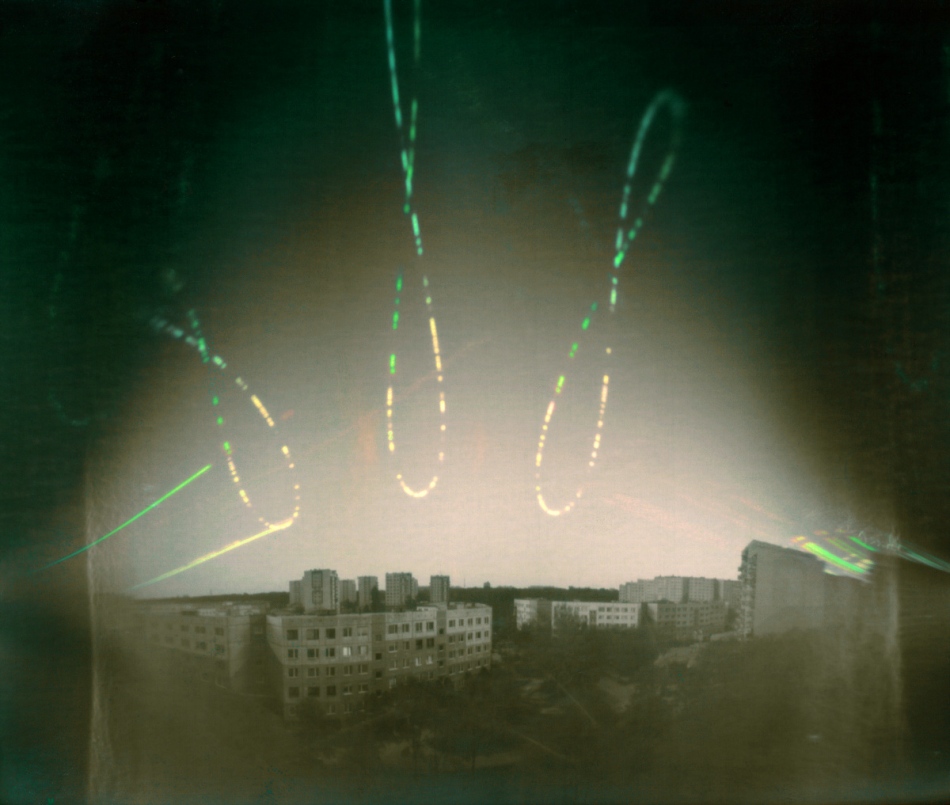 Today is the equinox. The Sun crosses the celestial equator heading north at 16:57 UT, marking the northern hemisphere's first day of spring. To celebrate, consider this remarkable image following the Sun's yearly trek through planet Earth's sky, the first analemmas exposed every day through the technique of solargraphy. In fact, three analemma curves were captured using a cylindrical pinhole camera by daily making three, separate, one minute long exposures for a year, from March 1, 2013 to March 1, 2014, on a single piece of black and white photographic paper. The well-planned daily exposures began at 10:30, 12:00, and 13:30, CET from a balcony looking south from the Kozanów district in Wrocław, Poland. That year's two equinoxes on March 20 and September 22 correspond to the mid-points, not the cross-over points, along the figure-8 shaped curves. Apparent gaps in the curves are due to cloudy days. Two solid lines at the lower left were both caused by a timer switch failure that left the pinhole shutter open.
__________________
1st in Kommisar's 2009 SM Tournament 1st in I Love You`s 2009 New Year`s Tournament 3rd in EnR's Mashfest '08 tournament 5th in Phynx's Unofficial FFR Tournament 9th in D3 of the 2008-2009 4th Official FFR Tournament 10th in D5 of the 2010 5th Official FFR Tournament 10th in D6 of the 2011-2012 6th Official FFR Tournament FMO AAA Count: 71 FGO AAA Count: 10 Bluearrowll = The Canadian player who can not detect awkward patterns. If it's awkward for most people, it's normal for Terry. If the file is difficult but super straight forward, he has issues. If he's AAAing a FGO but then heard that his favorite Hockey team was losing by a point, Hockey > FFR PS: Cool AAA's Terry - I Love You An Alarm Clock's Haiku beep beep beep beep beep beep beep beep beep beep beep beep beep beep beep beep beep - ieatyourlvllol |
|
|

|
|
|
#875 |
|
⊙▃⊙
|
Daily Suspicious0bserver's Weather Post:
March 21, 2014 What's in the sky tonight? March 21, 2014 -This year's huge "Winter Diamond" — bright Jupiter on top, bright Sirius on the bottom, and Procyon and Betelgeuse forming the left and right corners — persists well into spring. It stands straight up in the south around dusk, then tips westward as the evening advances. -China's lunar rover, the "Jade Rabbit", is awake and communicating with Earth. The rover had recently hunkered down to survive its third night on the Moon. Mission controllers weren't sure the Jade Rabbit could survive as darkness fell for two weeks and temperatures plunged as low as -170 C. But survive it did, although the rover can no longer move. Stuck in place, Jade Rabbit continues to gather data about its surroundings in Sinus Iridum (the Bay of Rainbows). The mission was designed to last only 3 months, so every byte that comes back now is a bonus. Astro Picture of the Day: March 21, 2014 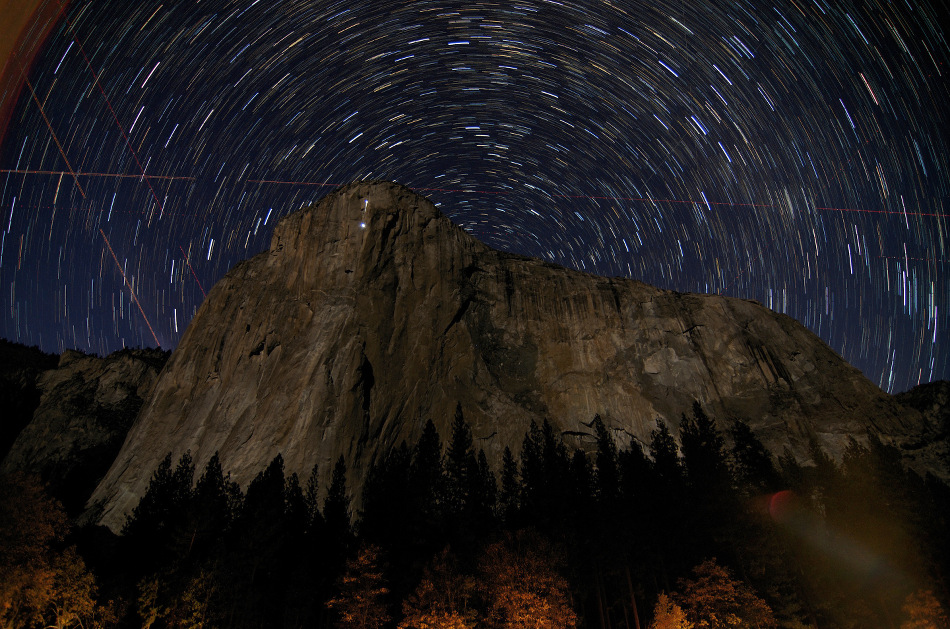 Towering 3,000 feet from base to summit, the famous granite face of El Capitan in Earth's Yosemite National Park just hides the planet's north celestial pole in this skyscape. Of course, the north celestial pole is at the center of all the star trails. Their short arcs reflecting the planet's daily rotation on its axis are traced in a digital stack of 36 sequential exposures. Linear trails of passing airplane navigation lights and a flare from car lights along the road below are also captured in the sequential stack. But the punctuated trail of light seen against the sheer El Capitan itself follows a climbing team on the night of November 8, 2013. The team is ascending toward the summit along The Nose, a historic rock climbing route.
__________________
1st in Kommisar's 2009 SM Tournament 1st in I Love You`s 2009 New Year`s Tournament 3rd in EnR's Mashfest '08 tournament 5th in Phynx's Unofficial FFR Tournament 9th in D3 of the 2008-2009 4th Official FFR Tournament 10th in D5 of the 2010 5th Official FFR Tournament 10th in D6 of the 2011-2012 6th Official FFR Tournament FMO AAA Count: 71 FGO AAA Count: 10 Bluearrowll = The Canadian player who can not detect awkward patterns. If it's awkward for most people, it's normal for Terry. If the file is difficult but super straight forward, he has issues. If he's AAAing a FGO but then heard that his favorite Hockey team was losing by a point, Hockey > FFR PS: Cool AAA's Terry - I Love You An Alarm Clock's Haiku beep beep beep beep beep beep beep beep beep beep beep beep beep beep beep beep beep - ieatyourlvllol |
|
|

|
|
|
#876 |
|
V's beta-male entourage
|
Sticky this again, tia
|
|
|

|
|
|
#877 |
|
⊙▃⊙
|
Daily Suspicious0bserver's Weather Post:
March 22, 2014 What's in the sky tonight? March 22, 2014 -When the stars come out this week, the Big Dipper is standing on its handle in the northeast. As evening grows late, the Dipper climbs higher and starts tipping to the left. -Long ago researchers thought solar flares were isolated events. Magnetic fields above a single sunspot became unstable and exploded--end of story. The Solar Dynamics Observatory's global view of the sun has shown, however, that widely-separated sunspots can explode in tandem. That's what happened on March 20th when AR2010 and AR2014 combined for a double flare. Transparent arcs of magnetism stretching across the 400,000 km divide between the two sunspots allow them to communicate magnetohydrodynamically, so instabilities in one can affect the other. This appears to be a textbook example of a 'sympathetic flare.' The most famous example occurred on August 1, 2010. SDO watched as instabilities jumped vast distances from one sunspot to another, setting off a chain reaction that engulfed more than half the sun. Compared to that global eruption, today's double flare was puny--or as puny as two explosions more powerful than a billion nuclear bombs can be. Welcome to the sun. 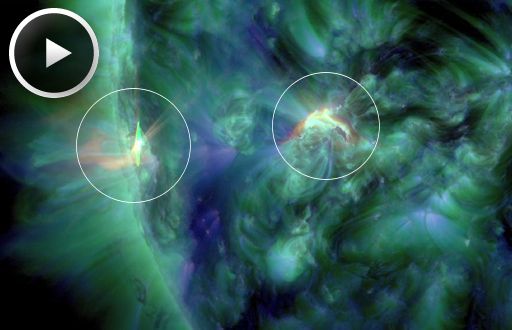 Astro Picture of the Day: March 22, 2014  Deep shadows create dramatic contrasts between light and dark in this high-resolution close-up of the martian surface. Recorded on January 24 by the HiRISE camera onboard the Mars Reconnaissance Orbiter, the scene spans about 1.5 kilometers across a sand dune field in a southern highlands crater. Captured when the Sun was just 5 degrees above the local horizon, only the dune crests are caught in full sunlight. With the long, cold winter approaching the red planet's southern hemisphere, bright ridges of seasonal frost line the martian dunes.
__________________
1st in Kommisar's 2009 SM Tournament 1st in I Love You`s 2009 New Year`s Tournament 3rd in EnR's Mashfest '08 tournament 5th in Phynx's Unofficial FFR Tournament 9th in D3 of the 2008-2009 4th Official FFR Tournament 10th in D5 of the 2010 5th Official FFR Tournament 10th in D6 of the 2011-2012 6th Official FFR Tournament FMO AAA Count: 71 FGO AAA Count: 10 Bluearrowll = The Canadian player who can not detect awkward patterns. If it's awkward for most people, it's normal for Terry. If the file is difficult but super straight forward, he has issues. If he's AAAing a FGO but then heard that his favorite Hockey team was losing by a point, Hockey > FFR PS: Cool AAA's Terry - I Love You An Alarm Clock's Haiku beep beep beep beep beep beep beep beep beep beep beep beep beep beep beep beep beep - ieatyourlvllol |
|
|

|
|
|
#878 |
|
⊙▃⊙
|
Daily Suspicious0bserver's Weather Post:
March 23, 2014 What's in the sky tonight? March 23, 2014 -Double shadow transit on Jupiter: Ganymede and Io are both casting their tiny black shadows onto the giant planet from 10:08 to 10:32 p.m. EDT (9:08 to 9:32 p.m. CDT). -Last quarter Moon (exact at 9:46 p.m. EDT). The Moon, in northern Sagittarius, rises around 2 or 3 a.m. Monday morning. By dawn Monday look for Antares very far to the Moon's right, Altair about equally far to the Moon's upper left, and bright Venus about equally far to its lower left. -A long line of sunspots is stretching across the sun's southern hemisphere, and at least two of them (AR2010 and AR2014) have 'beta-gamma' magnetic fields that harbor energy for M-class solar flares. NASA's Solar Dynamics Observatory photographed the "sunspot train" in motion on March 22nd. -Most of these sunspots are facing Earth, so if any of them erupts the blast would likely be geoeffective. NOAA forecasters estimate a 45% chance of M-class flares and a 5% chance of X-flares this weekend.  Astro Picture of the Day: March 23, 2014  In the center of a swirling whirlpool of hot gas is likely a beast that has never been seen directly: a black hole. Studies of the bright light emitted by the swirling gas frequently indicate not only that a black hole is present, but also likely attributes. The gas surrounding GRO J1655-40, for example, has been found to display an unusual flickering at a rate of 450 times a second. Given a previous mass estimate for the central object of seven times the mass of our Sun, the rate of the fast flickering can be explained by a black hole that is rotating very rapidly. What physical mechanisms actually cause the flickering -- and a slower quasi-periodic oscillation (QPO) -- in accretion disks surrounding black holes and neutron stars remains a topic of much research.
__________________
1st in Kommisar's 2009 SM Tournament 1st in I Love You`s 2009 New Year`s Tournament 3rd in EnR's Mashfest '08 tournament 5th in Phynx's Unofficial FFR Tournament 9th in D3 of the 2008-2009 4th Official FFR Tournament 10th in D5 of the 2010 5th Official FFR Tournament 10th in D6 of the 2011-2012 6th Official FFR Tournament FMO AAA Count: 71 FGO AAA Count: 10 Bluearrowll = The Canadian player who can not detect awkward patterns. If it's awkward for most people, it's normal for Terry. If the file is difficult but super straight forward, he has issues. If he's AAAing a FGO but then heard that his favorite Hockey team was losing by a point, Hockey > FFR PS: Cool AAA's Terry - I Love You An Alarm Clock's Haiku beep beep beep beep beep beep beep beep beep beep beep beep beep beep beep beep beep - ieatyourlvllol |
|
|

|
|
|
#879 |
|
⊙▃⊙
|
Daily Suspicious0bserver's Weather Post:
March 24, 2014 What's in the sky tonight? March 24, 2014 -By 10 or 11 p.m. Mars and Spica are well up in the southeast. Look almost two fists at arm's length to their right for the four-star pattern of Corvus, the Crow. Normally the Crow eyes Spica in Virgo's hand. Now he may be more interested in the brighter shiny right close by. -A CME launched from sunspot AR2014 on March 23rd is expected to deliver a glancing blow to Earth's magnetic field on March 25th. NOAA forecasters estimate a 30%-40% chance of polar geomagnetic storms on March 25-26. -Jupiter, among the legs of Gemini all week, forms the top of this year's Winter Diamond — which is still standing high as spring pushes winter aside. Procyon and Betelgeuse form the Diamond's side corners. This is how they're oriented in twilight as the stars come out. (Sirius is the Diamond's bottom.) The 3rd-magnitude star closest to Jupiter is Epsilon Geminorum, a yellow-orange supergiant 900 light-years away. Can you see its tint with your unaided eyes?  Astro Picture of the Day: March 24, 2014  If you see a sky like this -- photograph it. A month ago in Iceland, an adventurous photographer (pictured) chanced across a sky full of aurora and did just that. In the foreground lies the stratovolcano Öræfajökull. In the background, among other sky delights, lies the constellation of Orion, visible to the aurora's left. Auroras are sparked by energetic particles from the Sun impacting the magnetic environment around the Earth. Resultant energetic particles such as electrons and protons rain down near the Earth's poles and impact the air. The impacted air molecules obtain excited electrons, and when electrons in oxygen molecules fall back to their ground state, they emit green light. Auroras are known to have many shapes and colors.
__________________
1st in Kommisar's 2009 SM Tournament 1st in I Love You`s 2009 New Year`s Tournament 3rd in EnR's Mashfest '08 tournament 5th in Phynx's Unofficial FFR Tournament 9th in D3 of the 2008-2009 4th Official FFR Tournament 10th in D5 of the 2010 5th Official FFR Tournament 10th in D6 of the 2011-2012 6th Official FFR Tournament FMO AAA Count: 71 FGO AAA Count: 10 Bluearrowll = The Canadian player who can not detect awkward patterns. If it's awkward for most people, it's normal for Terry. If the file is difficult but super straight forward, he has issues. If he's AAAing a FGO but then heard that his favorite Hockey team was losing by a point, Hockey > FFR PS: Cool AAA's Terry - I Love You An Alarm Clock's Haiku beep beep beep beep beep beep beep beep beep beep beep beep beep beep beep beep beep - ieatyourlvllol |
|
|

|
|
|
#880 |
|
⊙▃⊙
|
Daily Suspicious0bserver's Weather Post:
March 25, 2014 What's in the sky tonight? March 25, 2014 -The biggest and brightest asteroids, 1 Ceres and 4 Vesta respectively, are only about 2° apart in eastern Virgo in the early morning hours, some 12° northeast of Mars. They've brightened to magnitudes 7.3 and 6.1, respectively. They'll be at opposition in mid-April. -Earth is looking down the double barrel of two potentially active sunspots: AR2010 and AR2014 have complex magnetic fields that harbor energy for strong eruptions, and both have grown since the week began. The CME expected to sideswipe Earth later today was propelled toward us by a C-flare from sunspot AR2014 on March 23rd. Otherwise the two sunspots have been mostly quiet. Is it the calm before the storm? NOAA forecasters estimate a 45% chance of M-class flares and a 5% chance of X-flares on March 25th 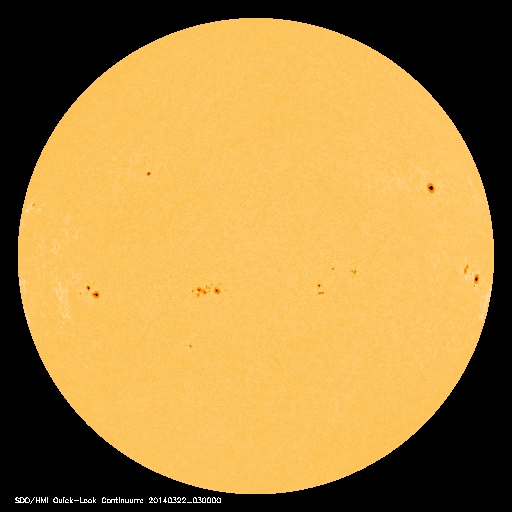 Astro Picture of the Day: March 25, 2014 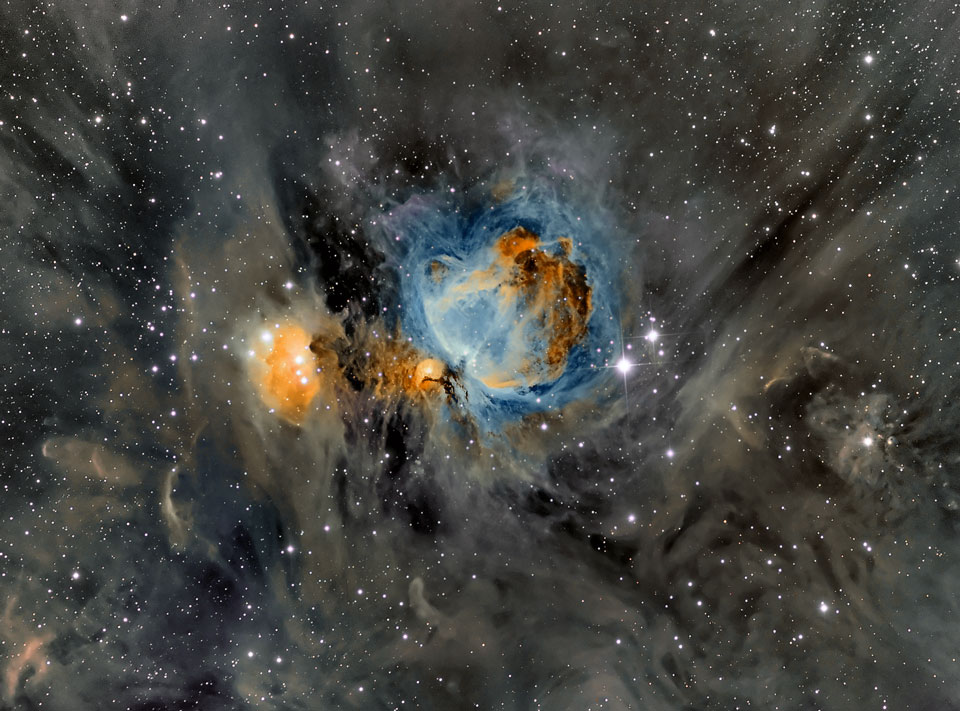 What surrounds a hotbed of star formation? In the case of the Orion Nebula -- dust. The entire Orion field, located about 1600 light years away, is inundated with intricate and picturesque filaments of dust. Opaque to visible light, dust is created in the outer atmosphere of massive cool stars and expelled by a strong outer wind of particles. The Trapezium and other forming star clusters are embedded in the nebula. The intricate filaments of dust surrounding M42 and M43 appear gray in the above image, while central glowing gas is highlighted in brown and blue. Over the next few million years much of Orion's dust will be slowly destroyed by the very stars now being formed, or dispersed into the Galaxy.
__________________
1st in Kommisar's 2009 SM Tournament 1st in I Love You`s 2009 New Year`s Tournament 3rd in EnR's Mashfest '08 tournament 5th in Phynx's Unofficial FFR Tournament 9th in D3 of the 2008-2009 4th Official FFR Tournament 10th in D5 of the 2010 5th Official FFR Tournament 10th in D6 of the 2011-2012 6th Official FFR Tournament FMO AAA Count: 71 FGO AAA Count: 10 Bluearrowll = The Canadian player who can not detect awkward patterns. If it's awkward for most people, it's normal for Terry. If the file is difficult but super straight forward, he has issues. If he's AAAing a FGO but then heard that his favorite Hockey team was losing by a point, Hockey > FFR PS: Cool AAA's Terry - I Love You An Alarm Clock's Haiku beep beep beep beep beep beep beep beep beep beep beep beep beep beep beep beep beep - ieatyourlvllol |
|
|

|
 |
| Currently Active Users Viewing This Thread: 1 (0 members and 1 guests) | |
|
|